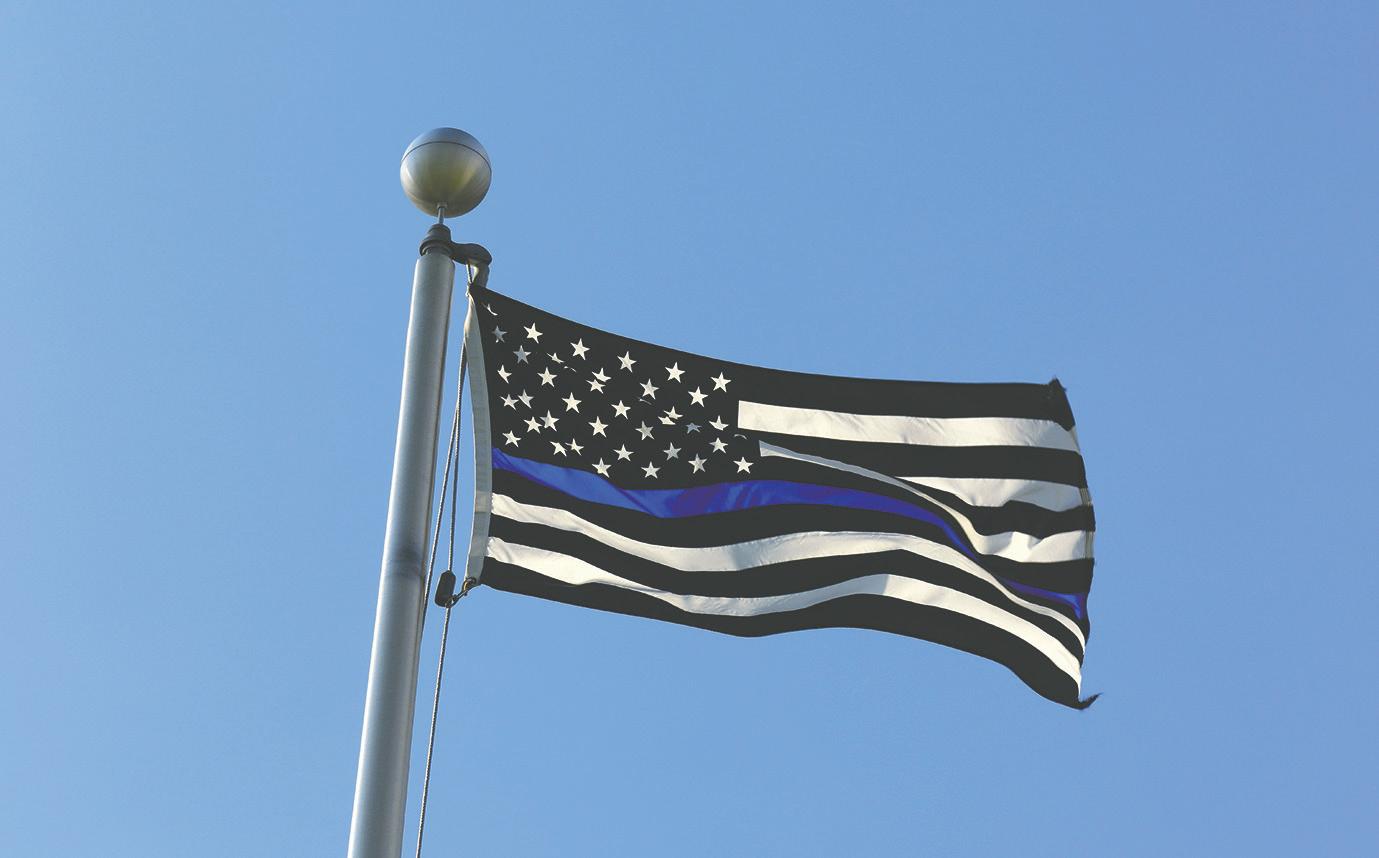Inside:
EMS Enhancement Services

Hometown Heroes
Law Enforcement Employee of the Year
In Memorium

















Inside:
EMS Enhancement Services

Hometown Heroes
Law Enforcement Employee of the Year
In Memorium
















The PCM School District has once again filled the school resource officer position. Officer Carter Riechmann, a Chariton native, is on the job and excited to get to know not only the students but the communities, as well.

“Having a little brother, kind of getting into the school setting was a pretty big deal to me,” Riechmann said. “Even before that, I took a bunch of classes in high school to become an elementary education teacher. I tore my ACL so my scholarship to place basketball got yanked and I realized I wanted to help everyone. I wanted to broaden out and be a role model for everyone, not just kids. Now that I am actually in the school I absolutely love it. It is kind of going back to my initial dreams were of being a teacher, I can do a little bit of that now.”
Riechmann received his AA from Indian Hills Community College and took his first position in law enforcement with the Lucas County Sheriff’s Office. Looking for a chance of pace, he moved to Ames and worked for Iowa State University. Serving a larger community ended up not being the change he wanted and an opportunity was presented to him by PCM’s former SRO Adam Choat.
“I worked for Iowa State University for a couple of months and I decided that isn’t where I wanted to be, I wanted more of a small town. The former SRO here said he knew of the opening and that I’d be perfect for the job,” Riechmann said. “I talked to (Monroe Police Chief) Nick (Chambers), did a couple of ride alongs and thought, ‘hey, I can see myself working here.’”
A short three weeks later and he was on the job. With headlines across the country often telling of school violence, Riechmann hopes to be a part of the solution and not just reacting to the problem.
“Seeing all of the unfortunate events that have been happening in schools around the nation, I want to be able to help ensure the safety of the kids here,” Riechmann said. “As
much as I want to say I can control it so it doesn’t happen, I just want to try to be as well trained as I can be.”
Through additional training during the summer and attending classes with the Na tional Association for School Resource Offi cers, he hopes to get more specific knowledge for working with students and in schools. He can then pass that on to the school adminis tration and teachers to help make PCM as safe as possible.
For now, he is really enjoying getting to know the students and building relationships throughout the district.
“(I hope to be) a role model for the kids. I know I’m tall and big and everyone looks up to me but I want them to do that for a different reason,” Riechmann said. “Just walking down the hall and having a kid run up and hug me, that was cool. Having only been in the schools for about three weeks and the fact that they feel OK with doing that is cool. I’m really hoping to kind of have it take off next year.”

When the reserve deputy paramedics of the Jasper County Sheriff’s Office arrived on scene to give an overdosing patient a life-saving dose of Narcan to temporarily reverse the symptoms of the narcotics they had consumed, the first words that came out of the man’s mouth were: “Thank you.”
Emergency response teams throughout Iowa — whether they are employed by a municipality or are strictly volunteers — have experienced moments like these in some form. But the decline of volunteerism is leaving some rural communities vulnerable to lower response times and, in some cases, less adequate care.

Jasper County Sheriff’s Office was thrust into a perfect opportunity last year to address the struggles of volunteer agencies and provide extra assistance by creating the advanced life support pilot program. With CARES Act and ARPA money funding the program, the county had the resources to fill in service gaps.


Steve Ashing, one of the two
reserve deputy paramedics that launched the program in March 2022, described the opportunity as a perfect storm, lightning in a bottle. Funds were available, two reserve deputies already had paramedic training, the need was there and the county supervisors were willing to try it out.
“Things have aligned just right to make this all work,” Ashing said in the early hours of his Thursday shift. “Having two paramedics as reserves, that is very unheard of in a lot of places. We had an opportunity with a sheriff who is very EMS- and fire service-driven and understands it, which is another anomaly.”
In addition to his duties as sheriff of Jasper County, John Halferty regularly volunteers for the fire department in Mingo, a town populated with a little more than 300 people. Ashing, too, has worked a volunteer crew in his 23-year career as a firefighter; for the past 16 years he has served at the Newton fire station.
When Newton receives an ambulance call, Ashing said there are


CONTINUED FROM 4
always two people who can respond, and then two to four more who can assist the primary responders within five minutes. Generally, there is always someone on scene with paramedic-level experience to administer advanced life support services.
However, when a rural EMS agency responds to a call, the likelihood of having a paramedic with a patient is less certain. Ashing said about every community — if not every community — in Jasper County has at least one paramedic. But life and other factors may limit that individual’s response time.

Which is where the sheriff’s office’s part-time reserve deputy paramedics come into play. When either Ashing or fellow paramedic Jacob Halferty arrive to a scene, they have to step in and serve as the primary care provider as they have the highest level of care experience among the volunteer EMTs.
Oftentimes the small town volunteers are still the first teams to respond to calls, but there have been instances where the reserve deputies administered care before other agencies arrived. John Halferty said there are good, dedicated people watching over the small towns, and the program is not taking them away.
When Ashing and Jacob Halferty are not responding to medical calls, they are still conducting duties as reserve deputies by providing backup to other deputies, patrolling communities, following up warrants, covering administrative duties, enforcing code violations and conducting traffic control.
Several of the volunteers in the small towns are EMTs, but that level of certification still limits what they can do. Ashing said an EMT can perform CPR, use AEDs, package wounds, stop bleeding and use splints, among other things. A lot of what an EMT does is assessing patients and recognizing conditions.
“Stroke, heart attacks, breathing
problems. Does this person have a breathing problem? Is it just a simple asthma-type thing? Or is it more? A lot of it assessing the patient and being able to know when to call a higher level (provider),” Ashing said.
“And they can’t give many medications themselves but they can assist.”
Apart from giving aspirin and glucose, EMTs may assist patients in taking medicine they are already prescribed, like an EpiPen.
Hours of schooling also differentiates EMTs from paramedics. For some people, Ashing said it is too much to ask a volunteer to dedicate the amount
of hours it takes to be a fully trained, fully certified paramedic. Unless they are working for a municipally owned fire/EMS station, there is not much incentive. Plus, it’s costly.
“It’s a daunting thing,” Ashing said. “You have to be the right person. EMT is a basic stage and gives you some basic knowledge of major life threats, major bleeding, major breathing issues. But it doesn’t get down into the nitty-gritty, the pathophysiology of different disease types that a paramedic does.” If there was an individual suffering
a heart attack in one of the rural parts of the county, all the first responders and EMTs know CPR and how to control the airway. But even then a care provider with advanced life support skills is needed to either provide medications or use other methods to restart the heart.
Emergencies that require a timely response to save the patient — like a heart attack or stroke — can still result in a death no matter if a paramedic is on scene or not. But getting that level of provider there is critical to ensuring each patient has the best care possible in their time of need.
“When you have a witness cardiac arrest and CPR is started and you get advanced care there as quickly as you can, you know they had the best opportunity,” Halferty said. “And the family knows that, too,”
— Steve Ashing
Things have aligned just right to make this all work.
Several familiar faces can be found on the side of a semi-trailer truck from Fareway Meat & Grocery. Service members and first-responders from Jasper County were featured prominently on
the trailer, the pictures of which were shared by the county sheriff’s office earlier this spring.
Jasper County Chief Deputy Duane Rozendaal, Jasper County Deputy Marc Headington, Newton Fire Captain Steve Ashing and Newton firefighter and
paramedic Jacob Halferty were some of the many “hometown heroes” displayed on both sides of the trailer wearing their respective gear.
In 2017, Fareway first unveiled a series of semi-trucks honoring public service members throughout the state.
The trailers at the time showcased photographs of 24 members from various branches of public service, including the Iowa National Guard, Iowa State Troopers and local law enforcement agencies.

CONTINUED FROM 6
The salute to service was presented by Fareway and Iowa Gov. Kim Reynolds and Lt. Gov. Adam Gregg. Fareway CEO Reynolds W. Cramer said at the time that the company wanted to show its appreciation to public services members’ commitment to protecting our freedoms.
“These trailers are a tribute to the great men and women serving Iowa and we thank them for their service,” Cramer said in a press release.


Reynolds commended first responders for making significant contributions to the state and its people, and she applauded their “tireless efforts” and sacrifices made by their families. Gregg appreciates Iowa companies like Fareway recognizing the importance of public service men and women.
According to Fareway’s website, the grocery store chain regularly partners with service member and first responder groups like Impact Iowa’s Heroes, Midwest Honor Flight, Operation Homefront and Polk County Sheriff’s Office.

Long before Jasper County Sheriff Deputy Marc Headington put on the badge he knew he wanted to serve. Since becoming a police officer and now a sheriff deputy, Headington has continued that pursuit and through his work he has been named the 2023 Law Enforcement Employee of the Year.
“I have kind of always had a call to serve, felt like a protector,” Headington said. “As a senior in high school, Van Meter is very small with K-12 in one building, I knew a fourth-grader who had his bike stolen and I felt compelled to figure out where it went. I eventually did find it.”

In his early adult life, he met the Van Meter Chief of Police and felt law enforce-







ment was the right fit. From there, he never looked back.



He began as a reserve peace officer in 1993 before starting full time as a police officer in the community of Afton in 1996. After a short stay there, he moved to Colfax where he was on the force until starting with the sheriff’s office in August 2002.
Through his 21 years as a deputy, Headington has served as a field training officer, firearms instructor, tactical team leader, animal control deputy and with the Honor Guard. According to his nomination paper, as a senior deputy, he “mentors and provides guidance to his fellow deputies. He leads by example with law enforcement safety and legal updates and


CONTINUED FROM 8
by physical fitness.
“He has honed his ability to deescalate and work through challenging situations with the citizens that we serve. He has routinely responded to incidents and calls for assistance when off duty.”
Though there are many experiences Headington has had on the job, one routine stop still sticks out as a memory of why he wanted to serve in the first place.

“One highlight that stands out was when there was a snow storm and I was working late evenings. A mom and her young sons slid off the road on High-
way F48 near the drive-in theater and went into the ditch,” Headington said. “I showed up, there was no one injured but their car was stuck in the snow, and I helped them get out of the car. I don’t know how old the boy was but when he got to the top of the road he just hugged my leg. It is just one of those things that was a routine call for me at that moment for him seemed like everything in his world was shaken up. For him to anchor to me, that always kind of stuck with me. It is one of the few times you get active feedback on the job that maybe you’re doing alright.”
About being nominated for Law Enforcement Employee of the Year, he said he could think of a list of reasons for every other person he works with to receive the honor.
“It is flattering. From my perspective, I just show
up, do what is asked of me, be as professional as I can at any given moment and try to be fair and consistent,” Headington said. “Anyone at the sheriff’s office will tell you I’m not subtle, if I’m thinking something I’ll probably say it. To know my peers are willing to nominate me for this is flattering. I could list everyone else why they should be getting it.”
Those that he has worked with along the way have made a big impression on him and will be what he misses and remembers most once he hangs up his badge.
“The guys I’ve worked with over the years, they are the high point,” Headington said. “When I call it a career it will be those folks that I miss, the other cops, the jailers, the dispatchers, the firefighters, they are just a solid group of folks.”






Chief Mike German joined in the Prairie City Police Department in 2014, taking over as police chief in 2020. He died of complications from COVID-19 Jan. 13, 2022. His death was considered a line of duty death. His badge number, 292, was retired by the Prairie City City Council.

Lieutenant Patrick Richardson joined the Newton Police Department July 28, 1990. He was promoted to lieutenant May 10, 2010. Lieutenant Richardson suffered a fatal heart attack Sept. 1, 2013, when he was exercising for the department’s agility test.


Officer Bobby Barrickman joined the Newton Police Department July 1, 1974. Officer Barrickman was killed Sept. 30, 1979, in a traffic accident while on
Officer Dan McPherren joined the Newton Police Department Dec. 4, 1973. Officer McPherren was shot and killed Sept. 13, 1985, when he responded with other officers to a robbery at a grocery store.

Officer Donald Rusty Hewitt served the Prairie City Police Department until the time of his death Dec. 3, 1977. Officer Hewitt was killed in an automobile accident during a high-speed pursuit.

Reserve Captain Howard Holdefer served the Jasper County Sheriff’s Office until the time of his death Oct. 30, 1973. Reserve Captain Holdefer suffered a fatal heart attack while assisting other deputies in the arrest of three individuals near Reasnor.



A group that no one ever wants to grow, is the fallen officers of Jasper County.German Richardson Barrickman McPherren Hewitt Holdefer File Photo Newton Police Officers walk by wreaths holding portraits of Officer Bobby Barrickman and Lt. Patrick Richardson, both of whom died on active duty, during a 2019 Peace Officers Memorial Day ceremony held on the Jasper County Courthouse lawn. File Photo Local law enforcement guards march down a sidewalk carrying flags during a 2019 Peace Officers Memorial Day ceremony held on the Jasper County Courthouse lawn.
duty.


National Police Week was created in 1962; after then-president of the United States, John F. Kennedy signed Public Law 87-726. The law designated May 15 as Peace Officers’ Memorial Day and stated that the week in which the day falls should be National Police Week. Every year, the National Law Enforcement Officers organize a Memorial Service to honor police officers who lost their lives in the line of duty.
Law enforcement has existed for centuries, although its officers haven’t always been known as ‘Police.’ In Ancient China, they were called ‘prefects.’ Old Babylonians called them ‘Paqūdu.’ In the Inca Empire, they called officials who held the roles of magistrates ‘Curaca.’ Inspectors or lower-level governors were called ‘Toqrikoq.’

The first centrally organized and uniformed police force was created during King Louis XIV’s reign in Paris in 1667. In 17th century Colonial America, the most important law enforcement official was the county sheriff. In 1789, the United States Marshals Service was established, and other federal law enforcement agencies started popping up, such as the U.S. Parks Police. However, the first organized and publicly-funded professional full-time police force wasn’t established until 1838 in Boston.

The United States police force has developed since then to become a powerful one, with dedicated officers. The goal of National Police Week is to honor and celebrate these officers. Individuals and governments have a responsibility to honor their brave and hardworking law enforcement on this day. In October 2020, the United States approved legislation authorizing the construction of a national law enforcement museum on federal property directly across the street from the law enforcement officers’ memorial.
